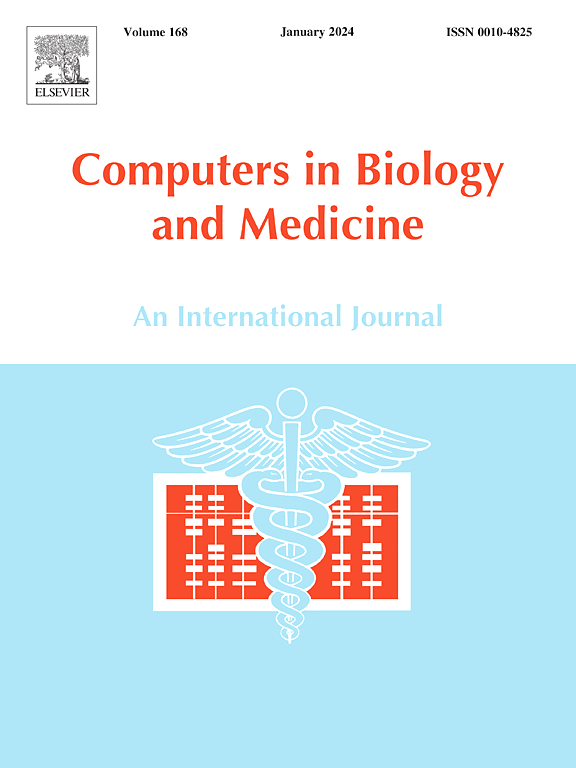KC-UNIT: Multi-kernel conversion using unpaired image-to-image translation with perceptual guidance in chest computed tomography imaging
IF 6.3
2区 医学
Q1 BIOLOGY
引用次数: 0
Abstract
Computed tomography (CT) images are reconstructed from raw datasets including sinogram using various convolution kernels through back projection. Kernels are typically chosen depending on the anatomical structure being imaged and the specific purpose of the scan, balancing the trade-off between image sharpness and pixel noise. Generally, a sinogram requires large storage capacity, and storage space is often limited in clinical settings. Thus, CT images are generally reconstructed with only one specific kernel in clinical settings, and the sinogram is typically discarded after a week. Therefore, many researchers have proposed deep learning-based image-to-image translation methods for CT kernel conversion. However, transferring the style of the target kernel while preserving anatomical structure remains challenging, particularly when translating CT images from a source domain to a target domain in an unpaired manner, which is often encountered in real-world settings. Thus, we propose a novel kernel conversion method using unpaired image-to-image translation (KC-UNIT). This approach utilizes discriminator regularization, using feature maps from the generator to improve semantic representation learning. To capture content and style features, cosine similarity content and contrastive style losses were defined between the feature map of generator and semantic label map of discriminator. This can be easily incorporated by modifying the discriminator's architecture without requiring any additional learnable or pre-trained networks. The KC-UNIT demonstrated the ability to preserve fine-grained anatomical structure from the source domain during transfer. Our method outperformed existing generative adversarial network-based methods across most kernel conversion methods in three kernel domains. The code is available at https://github.com/cychoi97/KC-UNIT.

KC-UNIT:在胸部计算机断层成像中使用非配对图像到图像转换的多核转换和感知引导
计算机断层扫描(CT)图像是利用各种卷积核通过反投影从原始数据集(包括正弦图)重建的。核的选择通常取决于被成像的解剖结构和扫描的特定目的,平衡图像清晰度和像素噪声之间的权衡。一般来说,正弦图需要很大的存储容量,而存储空间在临床环境中往往是有限的。因此,在临床环境中,CT图像通常只重建一个特定的核,而正弦图通常在一周后被丢弃。因此,许多研究者提出了基于深度学习的CT核转换方法。然而,在保留解剖结构的同时转移目标核的样式仍然具有挑战性,特别是当以不配对的方式将CT图像从源域转换到目标域时,这在现实世界中经常遇到。因此,我们提出了一种新的核转换方法,使用非配对图像到图像的转换(KC-UNIT)。该方法利用鉴别器正则化,使用来自生成器的特征映射来改进语义表示学习。为了捕获内容和风格特征,在生成器的特征映射和鉴别器的语义标签映射之间定义余弦相似内容和对比风格损失。这可以很容易地通过修改鉴别器的架构来实现,而不需要任何额外的可学习或预训练的网络。KC-UNIT展示了在转移过程中从源域保存细粒度解剖结构的能力。我们的方法在三个核域的大多数核转换方法中优于现有的基于生成对抗网络的方法。代码可在https://github.com/cychoi97/KC-UNIT上获得。
本文章由计算机程序翻译,如有差异,请以英文原文为准。
求助全文
约1分钟内获得全文
求助全文
来源期刊

Computers in biology and medicine
工程技术-工程:生物医学
CiteScore
11.70
自引率
10.40%
发文量
1086
审稿时长
74 days
期刊介绍:
Computers in Biology and Medicine is an international forum for sharing groundbreaking advancements in the use of computers in bioscience and medicine. This journal serves as a medium for communicating essential research, instruction, ideas, and information regarding the rapidly evolving field of computer applications in these domains. By encouraging the exchange of knowledge, we aim to facilitate progress and innovation in the utilization of computers in biology and medicine.
 求助内容:
求助内容: 应助结果提醒方式:
应助结果提醒方式:


